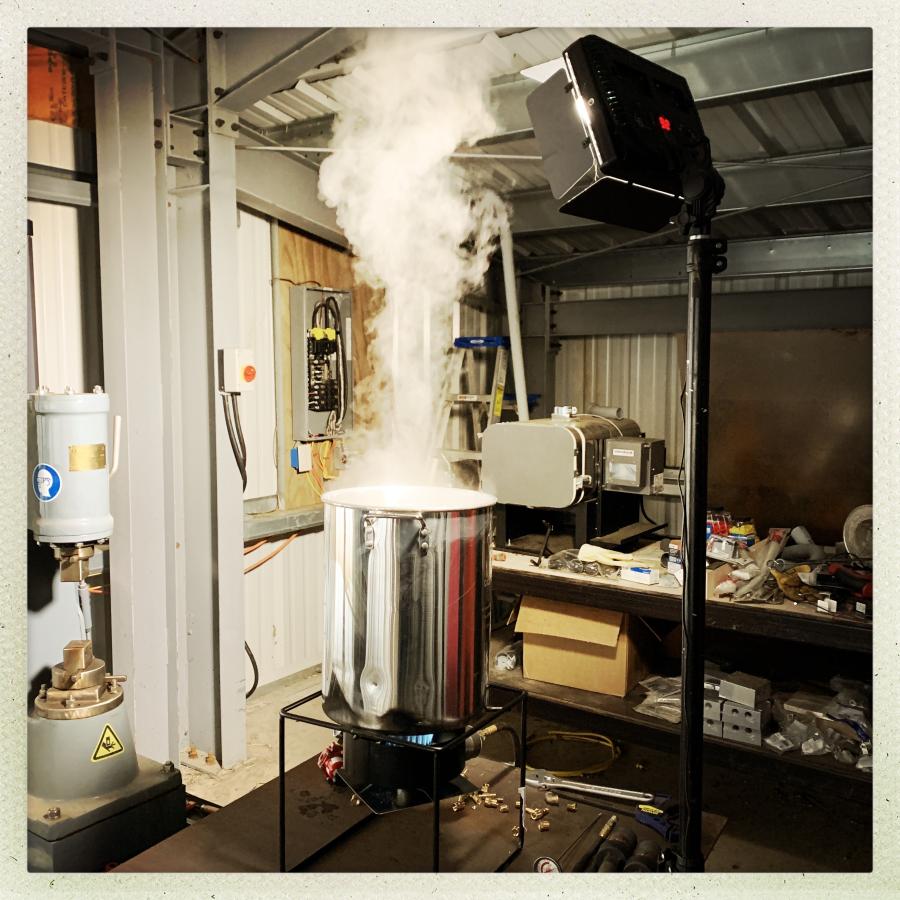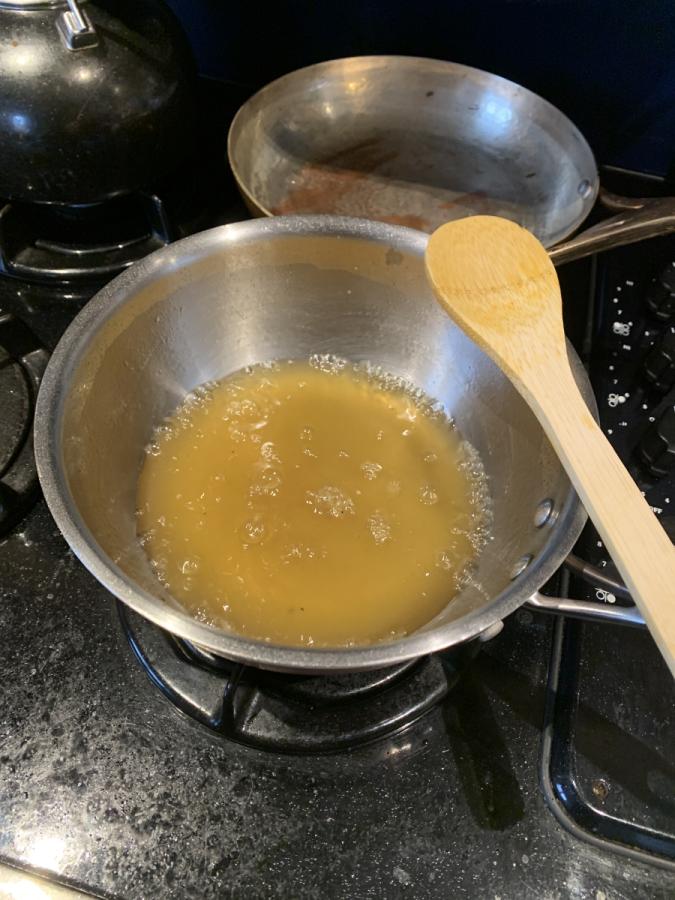Once I had the burner ring working, I set up a big pot (a turkey frier I picked up at TSco) and … That was it.
There is always work to be done in the shop, so I didn’t have to leave the burner unattended – I pulled wire, pushed the presses into position and tested that their motors still function the hydraulics. I even powered up the Anyang hammer and bookmarked that I need to fill its oil tank.
It’s a big thing for me that I got the propane hookup, even if only to a burner ring, because I just need to run electricity to one more outlet and I can fire the forge.
I also need to make a little shelter/temple for my statue of ‘Festus, god of the forge. So many things to do!

Cabinets. I have to assemble the cabinets. And put a few things away.

Once the syrup was starting to get thick, I took the whole lot back to the kitchen, where I could control the heat better and had better lighting.

I know what some of you are thinking: “a ground glass stopper? for sugar-water?” but it’s OK, that’s just a temporary bottle and it’s going to be tested on a waffle this weekend.
It is actually quite good!

I used to have a neighbor who tapped his maples each spring, and had a sugar shack to process it. (A small shed that contains a wood fired stove and large kettles)
The woods around their house smelled amazing. Wood smoke and maple.
I do believe it is good! Bon Apetit.
I would love to try and make my own maple syrup too. There are three huge sycamore maples behind my house, and whilst they have less sugar in their sap than the North American species, they are suitable for making maple syrup. Alas, the trees are not on my property. My neighbor probably would not mind, but I cannot be arsed to bother him, especially since I do not actually like sugar maple, I would just like to try the process *scratches head*.
Looks tasty!
Mm-maple syrup. Here, birch sap is sometimes tapped and consumed, we have no sugar maples here.
You know what we call a ground-glass joint in Finnish? It’s a hios, a neologism derived from the verb hioa (to grind a surface in order to affect the surface quality or the shape of an object).
i never thought of festus as short for hephaestus, that’s funny
I think a ground glass stopper is quite appropriate. You now know better than most folks just how precious real maple syrup is.
Since I don’t know what fresh from the tree maple sap tastes like, I’ve always wondered if there’s enough sugar in the sap that drips from my grape vines when I prune them in the spring (never get around to doing it properly in the fall) to distill into a syrup, and how it would taste if I did. It doesn’t taste very sweet, but is more like the most delicious spring water ever. I just don’t have the patience to hang around long enough to collect any more than a small cupful to drink, nor the industry to set up a collection system. But I still think an enterprising vineyard could make some extra cash off that sap somehow, either as a luxury designer water or syrup, if that works. Spring pruning hasn’t seemed to hurt the vine but then I’m not monitoring it for grape yield or anything.
More than a waffle’s worth unless you are dissolving the waffle in the syrup. Fine work, and now you have the kit it would be a shame not to use it next year … *runs away giggling*
Ice Swimmer, I had a friend who made birch wine from the sap, which as an inexpereinced teen I thought was nice. Probably means it was over sweet, or at least lacking in any tannins.
@Ridana #7
I poked around Wikipedia a bit to see if such a thing as grape vine sap syrup exists, and could not find any mention of it although it is amazing how many different kinds of plants can be used to make sugars or syrups.
The Italians make Grappa from the skins, seeds, and stems leftover from winemaking, and I believe the vine trimmings are often dried and used to smoke meats and cheeses, however if it is possible to make usable quantities of syrup from vine sap I would think some European would have figured it out sometime in the last couple of millennia.
@Ridana, the sap probably does contain some sugar, but from a grapevine, you would not be able to collect enough to make any meaningful amount of syrup.
I had an unseemly sycamore tree in my garden and I had to fell it in 2014. Icicles formed on some of the cuts overnight and I theorized they might be sap. So I collected them and from about 250 ml of this fluid, I have got a teaspoon of very tasty caramel. That is how I know that sycamore trees could be used to make maple syrup.
I wonder whether maple syrup stans and honey stans ever get into arguments over which is better: tree blood or bee vomit. It’s all just sugar, with impurities.
Here is a really simple recipe for maple syrup custard:
2 eggs
1.5 cups milk
6 TBSP (3/8 cup) maple syrup
1/4 tsp vanilla extract
sprinkling of nutmeg
Preheat oven to 350 F.
Lightly beat eggs. Add milk, syrup and vanilla. Mix and pour into 8″ x 8″ oven safe glass dish. Sprinkle nutmeg on top.
Bake 35-45 minutes, until knife comes out clean.
Chill at least an hour to set it up.
That looks amazing, both the setup and the final product. I am glad it worked out.
Nice colour.
Excellent! The end results look very waffle-worthy. The new place seems to be coming along nicely as well. That will be exciting when you can light up that forge.
Looks delicious.
As an electrician I’m duty bound to suggest you put the cover on you breaker panel. Grindings, chemicals, and easy access by critters can cause issues best avoided.
I once had a boss speechify about how panels were dangerous while waving around a pencil. He carelessly touched the aluminum ferrule to the lugs and blew the end off the pencil. He stormed off red-faced but the point was made. You have to be careful.
@Charly
I think you’re wrong about that, though it might depend on the definition of “meaningful.” I can get a quarter cup of sap from a single vine in about 15 min, which is about the longest it runs before it clots over (I should try tasting the clot to see if it’s sweet – it’s just that it looks like snot, so…). If I put a tube over the vine so the cut edge wasn’t exposed to the air, maybe it would run longer? Better yet, if I tapped the main trunk directly… :) Anyway, without knowing the sugar content, I have no way to know how much I’d need to collect to do anything with, but as I said, it’s unbelievably delicious to just drink straight, so I do.
.
@moarscienceplz, yeah, I’d think someone would’ve done this ages ago too, but then a) they likely prune their vines when the sap is not flowing, and b) they probably value the grapes over water or syrup and would not risk jeopardizing the yield or health of the plant for this (I’d imagine spring cutting could open a path for viruses or other pathogens or parasites in a large vineyard).
Maybe this year I’ll try some things and see what happens. :) Or not.
Btw, to be clear, if I wipe off the clot, it starts flowing again, so it’s not like I’ve got 15 m or less to get what I can and that’s it. I’m just too lazy to hang around much longer than that, so if I were serious about this, I’d need to come up with a different collection strategy.
I should just get a nice sample, have a lab do an extensive analysis on its content, then create my own designer water from that recipe. ;)
Not so easy, but it got done:
F-35C fighter jet recovered from South China Sea
It seems like some people are looking into using reverse osmosis to pre-process the sap. In case you want another project to try :P
Wasn’t there a discussion about tree saps as slightly sweet or sometimes fermented and slightly alcoholic beverages go on somewhere around hereabouts a couple years back? I feel like there was a pretty significant exchange, with Andreas Avester providing a lot of significant info?
Anyways, I remember as a kid, reading “survival” books that you could supposedly cut hanging loops of grapevine and drink water from them, but I never managed to get any sort of notable liquid after cutting any sort of hanging vines I encountered (mostly wild/feral grape, but likely some virginia creeper and a few other things…). but then again, “survival” books can be full of highly questionable information/claims…
I also suspect that even if the grapevine sap could be relatively easily (for certain values of “easy”…) used for sugar, the grapes themselves are probably more important. I don’t think there is really anything notable for humans to get from maples aside from sap and wood, and if you have a homestead or farm or similar, might as well tap the maples on the borders/woodlots/fencerows, and get a bit of sugar water when you can.
I think there was also something about sugar pines? and using spruce tips to make drinks/alcohol? Also, I think sugar sources were probably far more important before global trade and sugarcane plantations. If you are living in a temperate climate, without global trade, your main sweet foods are probably going to be random (seasonal) fruits, maybe a bit of honey, and maybe something like malted barley/grains, and maple/birch/pine sap (also seasonal). We are kind of lucky in that despite all the other bad stuff happening, most of us have pretty easy and cheap access to numerous sugars. I think that’s pretty unusual compared to much of human history…
Italy’s rare, surprisingly bitter honey
Friday morning Anna and I had applewood smoked bacon, waffles and the homemade syrup. The syrup is light and delicious with vanilla highlights – it was a good breakfast!
I am happy to hear that the syrup experiment resulted in a good breakfast for you and Anna. There really is no comparison between real maple syrup, and the cheap maple flavored corn syrup.
In the southern US, you can find sorghum syrup. Its also delicious, with a distinctive nutty sweet flavor. However you can’t pour it, you slap a stick into it and then apply the treacle in the middle of a hot roll so it melts.
I do plan to sample the grape sap after reading this thread. I’ve observed squirrels chewing into grapevines in order to drink the rising sap, but it never occurred to me to taste it. Young grape tendrils are very tasty woodland snacks if you like a mild lemon flavor.
Syrup aged in bourbon barrels ‘sells like hotcakes’